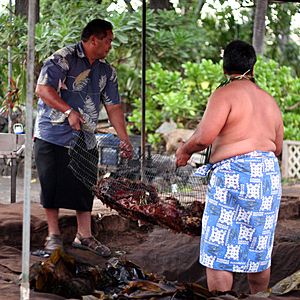Kālua facts for kids
Kālua is a special Hawaiian way of cooking food. It uses an imu, which is like an underground oven. The word "kālua" means "to cook in an underground oven" in the Hawaiian language. It can also describe the food cooked this way.
You might hear about kālua pig or kālua turkey. These foods are often served at big Hawaiian parties called lūʻau. The word lūʻau actually means the young leaves of the taro plant. These leaves look like cooked spinach after they are steamed. In the past, people ate traditional lūʻau meals on the floor. They used mats made from lauhala, which are woven leaves from the hala tree.
Contents
What is Kālua Cooking?
Kālua is a unique cooking method that uses the earth itself as an oven. It's a very old tradition in Hawaii. This way of cooking makes food super tender and gives it a special smoky flavor.
How to Build an Imu (Underground Oven)
First, people dig a pit in the ground. This pit needs to be big enough for the food, stones, and plants used for cooking. Then, a fire is built inside the pit using hardwood.
Stones are placed on top of the fire. These stones heat up for about two to three hours. It's important to pick stones that don't have much water inside. This stops them from exploding when they get very hot.
Preparing the Imu for Cooking
Once the stones are super hot, they are spread out over the coals. The pit is then lined with soft plants. These can be things like banana tree trunks that have been flattened.
Next, a layer of ti leaves (from the Cordyline fruticosa plant) is spread over the banana leaves. The food to be cooked is placed on top of these layers. If it's a whole pig, some hot stones are even put inside the pig. This helps make sure the meat cooks all the way through.
Cooking the Food in the Imu
To keep the heat even and the meat juicy, more layers of plants are added. These include more ti and banana leaves. Then, the whole pit is covered with several inches of soil. It's important that no steam can escape.
The plant layers covering the food must go past the edges of the pit. This stops the soil from touching the food. The meat then cooks in the pit for many hours.
After Cooking: Shredding the Meat
When the meat is fully cooked, it's carefully taken out of the imu. Then, it's usually shredded into pieces. This makes it easy to serve and enjoy.
Sometimes, people use modern changes to this old method. They might use wet burlap instead of some plants. Or they might use a special metal mesh to help lift the food out. The smoky taste of kālua pig comes from the hardwood fire. But the special flavor also comes from the ti leaves used to wrap the meat. This is what makes kālua pig taste different from other slow-cooked pork.
Kālua Pig Today
Kālua pig is a big attraction for visitors at many lūʻau events. However, sometimes it's made in a regular oven. They might use gas or electric stoves. To get a smoky taste, they add artificial smoke flavors. These can be from mesquite or kiawe wood.
Some businesses use other things instead of traditional plants. Or they might use an imu pao. This is a type of imu that is built above the ground.
Hawaiian cook Sam Choy uses the term "kālua pork" for a different recipe. He rubs pork shoulder with sea salt. Then he wraps it in ti leaves. It's slowly cooked in an oven with liquid mesquite smoke. This is different from using an imu.
External links
See also
 In Spanish: Imu (horno hawaiano) para niños
In Spanish: Imu (horno hawaiano) para niños


